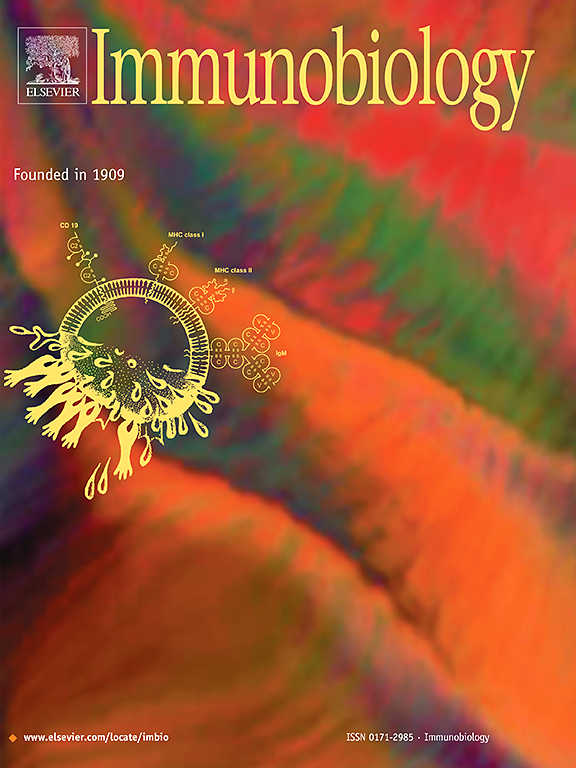STING modulates HBV-related acute-on-chronic liver failure by mediating autophagy and macrophage polarization
IF 2.3
4区 医学
Q3 IMMUNOLOGY
引用次数: 0
Abstract
Background & Aims
HBV-related acute-on-chronic liver failure (HBV-ACLF) is a severe acute liver injury secondary to HBV-related chronic liver disease (with or without cirrhosis) and is characterized by a high short-term mortality rate. Presently, there is a paucity of experimental models that specifically focus on HBV-ACLF based on chronic hepatitis B. Therefore, this study aimed to establish an experimental mouse model of HBV-ACLF using chronic hepatitis B (CHB) as a basis and investigate the impact of STING activation on the disease.
Methods
To simulate HBV-ACLF conditions, a model was constructed by combining chronic HBV replication (caudal vein high-pressure hydrodynamic injection of pAAV/HBV1.2 plasmid) and acute hepatic insult (intraperitoneal injection of Acetaminophen (APAP)). Then, model mice were administered either a STING agonist or STING inhibitor. Liver injury, STING pathway, autophagy flux, and macrophage polarization were assessed to elucidate the potential role of STING.
Results
The mouse model developed chronic hepatitis B and acute liver injury, partially reflecting features of clinical HBV-ACLF based on CHB. STING activation, autophagy, and macrophage polarization were found to be involved in the disease process. During the early stage (6 h) of the STING agonist treatment group, the STING pathway was activated, autophagy flux was up-regulated, and liver inflammation and injury were alleviated. Contrastingly, at the late stage of STING agonist treatment (24 h, 48 h), macrophages were polarized to the M1 phenotype, exacerbating liver inflammatory infiltration and injury. However, treatment with a STING covalent inhibitor reversed these effects.
Conclusions
Sting-induced autophagy exerts a protective effect on liver injury during the early stage. However, in later stages, STING may aggravate liver injury by shifting liver macrophage polarization to the M1 phenotype, thereby enhancing the inflammatory response.
STING通过介导自噬和巨噬细胞极化调节hbv相关的急慢性肝衰竭。
背景与目的:hbv相关的急性慢性肝衰竭(HBV-ACLF)是一种继发于hbv相关的慢性肝病(伴或不伴肝硬化)的严重急性肝损伤,其特点是短期死亡率高。目前,专门针对慢性乙型肝炎HBV-ACLF的实验模型缺乏。因此,本研究旨在以慢性乙型肝炎(chronic hepatitis B, CHB)为基础,建立小鼠HBV-ACLF实验模型,探讨STING激活对该疾病的影响。方法:建立慢性HBV复制(尾静脉高压流体动力注射pAAV/HBV1.2质粒)和急性肝损伤(腹腔注射对乙酰氨基酚(APAP))相结合的模型,模拟HBV- aclf条件。然后,给模型小鼠注射STING激动剂或STING抑制剂。通过评估肝损伤、STING通路、自噬通量和巨噬细胞极化来阐明STING的潜在作用。结果:小鼠模型发生慢性乙型肝炎和急性肝损伤,部分反映了以慢性乙型肝炎为基础的临床HBV-ACLF特征。发现STING激活、自噬和巨噬细胞极化参与了疾病过程。在STING激动剂治疗组的早期(6 h), STING通路被激活,自噬通量上调,肝脏炎症和损伤减轻。相反,在STING激动剂治疗的后期(24 h, 48 h),巨噬细胞极化到M1表型,加剧了肝脏炎症浸润和损伤。然而,用STING共价抑制剂治疗逆转了这些作用。结论:蜇伤诱导的自噬对早期肝损伤具有保护作用。然而,在后期,STING可能通过使肝巨噬细胞极化向M1表型转变,从而增强炎症反应,从而加重肝损伤。
本文章由计算机程序翻译,如有差异,请以英文原文为准。
求助全文
约1分钟内获得全文
求助全文
来源期刊

Immunobiology
医学-免疫学
CiteScore
5.00
自引率
3.60%
发文量
108
审稿时长
55 days
期刊介绍:
Immunobiology is a peer-reviewed journal that publishes highly innovative research approaches for a wide range of immunological subjects, including
• Innate Immunity,
• Adaptive Immunity,
• Complement Biology,
• Macrophage and Dendritic Cell Biology,
• Parasite Immunology,
• Tumour Immunology,
• Clinical Immunology,
• Immunogenetics,
• Immunotherapy and
• Immunopathology of infectious, allergic and autoimmune disease.
 求助内容:
求助内容: 应助结果提醒方式:
应助结果提醒方式:


